Welcome Back Letter To Teachers
[Your School's Logo/Header]
[Date]
Dear [Teacher's Name],
Welcome back to another exciting school year! I hope this letter finds you well and rejuvenated after a well-deserved break. As we prepare to embark on this new academic journey, I wanted to take a moment to express my heartfelt gratitude and share my excitement for having you as an essential part of our school community once again.
Over the years, your dedication and passion for teaching have left a lasting impact on countless young minds. Your commitment to fostering a positive learning environment and encouraging students to reach their full potential is truly commendable. Your efforts have not gone unnoticed, and we deeply appreciate the hard work you put in day after day to make our school a better place.
As we embrace the challenges and opportunities that lie ahead, I am confident that your expertise, creativity, and unwavering support for your students will continue to inspire and shape the future leaders of tomorrow. Your influence extends far beyond the classroom, instilling values and knowledge that will stay with your students throughout their lives.
This year, we will work together as a team, collaborating to develop innovative teaching methods and enhance the overall learning experience for our students. I encourage you to share your ideas, insights, and suggestions, as your unique perspectives contribute significantly to the growth of our school and the success of our students.
As the new school year unfolds, we will also focus on fostering a supportive and nurturing environment for our teachers. Your well-being is of utmost importance, and we are committed to providing the necessary resources and opportunities for your professional development.
Please mark your calendars for our upcoming staff meeting on [date] to discuss the plans and goals for the academic year. I look forward to hearing your valuable input and having productive discussions on how we can create an even more enriching experience for our students.
Once again, welcome back to the [School Name]. Together, let us make this academic year one filled with growth, inspiration, and joy for both teachers and students alike.
If you have any questions or need assistance before the school year begins, feel free to reach out to me. I am always here to support you.
Here's to a fantastic year ahead!
Warm regards,
[Your Name]
[Your Title/Position]
[School Name]
[Contact Information]
Welcome Back Letter from Principal to Teachers - Professional and Encouraging
Subject: Welcome Back to a New School Year!
Dear Colleagues,
Welcome back! I hope this message finds you refreshed and ready to embark on another exciting school year. Your dedication to our students and commitment to excellence continue to be the cornerstone of our school's success.
As we begin this academic year, I want to acknowledge the incredible work you do every day. Teaching is both an art and a science, and each of you brings unique strengths to our learning community. This year promises new opportunities for growth, innovation, and collaboration.
We have several exciting initiatives planned, including enhanced professional development opportunities, updated classroom resources, and new collaborative spaces. I encourage you to share your ideas and feedback as we continue to evolve and improve.
Please review the attached schedule for our opening week meetings and professional development sessions. If you have any questions or concerns, my door is always open.
Here's to a wonderful year ahead filled with learning, laughter, and meaningful connections with our students.
Warm regards,
[Principal Name]
[School Name]
Welcome Back Message from Department Head - Collaborative and Supportive
Subject: Excited to Begin Our Work Together!
Hello Team,
Welcome back to what I know will be an outstanding year! I've spent the summer reflecting on our department's achievements and envisioning how we can continue to support each other and our students.
This year, our focus will be on collaborative planning and sharing best practices. I've scheduled monthly department meetings where we can discuss curriculum updates, student progress, and innovative teaching strategies. Your input is invaluable, and I want to ensure everyone has a voice in our decision-making process.
I've also arranged for some exciting professional development opportunities specific to our subject area. Details will be shared at our first meeting on [date].
Please don't hesitate to reach out if you need resources, support, or just want to brainstorm ideas. We're stronger together, and I'm here to help you succeed.
Looking forward to working alongside all of you!
Best,
[Department Head Name]
Welcome Back Email from Colleague to Colleague - Warm and Casual
Subject: Ready for Round Two? ☕
Hey [Name],
Hope you had an amazing summer! I'm both excited and slightly terrified that we're back already. Time really does fly when you're not grading papers, doesn't it?
I wanted to reach out before the chaos begins to see if you'd like to grab coffee before the first day. It would be great to catch up and maybe coordinate some cross-curricular projects like we talked about last spring.
Also, I found some fantastic resources over the summer that I think would work perfectly for both our classes. Would love to share them with you!
Let me know when you're free. Looking forward to another year of surviving staff meetings together!
Cheers,
[Your Name]
Welcome Back Letter from Returning Teacher to Students' Parents - Friendly and Professional
Subject: Welcome Back! Excited for the Year Ahead
Dear Families,
Welcome back to a new school year! I hope you and your family enjoyed a wonderful summer filled with rest and adventure. I'm thrilled to have the opportunity to work with your child again this year.
As we begin this academic journey together, I want to share my goals and expectations. This year, we'll be focusing on [specific learning objectives], building upon the foundation we established last year. I believe in creating a supportive, challenging environment where every student can thrive.
Communication between home and school is essential for student success. I'll be sending weekly updates about our classroom activities, upcoming assignments, and important dates. Please feel free to contact me anytime via email at [email] or phone at [number]. I typically respond within 24 hours during weekdays.
I've attached our class syllabus, supply list, and important dates for your reference. Please review these with your child and reach out with any questions.
I'm looking forward to partnering with you to make this an exceptional year for your child!
Warmly,
[Teacher Name]
[Grade/Subject]
Welcome Back Message from New Teacher to Fellow Staff - Enthusiastic and Humble
Subject: Hello from the New Teacher!
Dear Colleagues,
My name is [Name], and I'm the new [subject/grade] teacher joining your incredible team this year. While "Welcome Back" might not apply to me just yet, I wanted to introduce myself and express how excited I am to be part of this school community.
I recently graduated from [University] with a degree in [field], and I've completed my student teaching at [Previous School]. Though I'm new to the profession, I'm eager to learn from experienced educators like yourselves.
I know starting at a new school means I'll have a lot to learn about procedures, culture, and expectations. I would deeply appreciate any guidance, advice, or mentorship you're willing to offer. Please don't hesitate to point me in the right direction if you see me looking lost!
I'm passionate about [teaching philosophy/subject], and I can't wait to contribute to our students' success. If you have a moment, I'd love to connect over coffee or lunch to learn more about the school and how I can best support our team.
Thank you for welcoming me into your professional family!
Sincerely,
[New Teacher Name]
Welcome Back Letter After Extended Leave - Grateful and Reassuring
Subject: I'm Back and Ready!
Dear Students and Colleagues,
I'm writing to let you know that I'm returning to school after my extended leave. First, I want to express my heartfelt gratitude to [substitute teacher name] for their excellent work during my absence, and to all of you for your patience and understanding.
I've missed being in the classroom and connecting with each of you. While I was away, I kept up with the curriculum and have been in contact with [substitute/administrator] to ensure a smooth transition back.
For my students: We'll pick up right where we left off, and I'll be reviewing recent material to make sure everyone is on track. If you have any concerns or questions about assignments or grades from the past [time period], please see me during office hours or send me an email.
For my colleagues: Thank you for covering my duties and supporting my students during my absence. I'm ready to resume my full responsibilities and contribute to our team again.
I'm energized and looking forward to finishing this school year strong together!
With appreciation,
[Teacher Name]
Welcome Back Email from Administrator About New Changes - Official and Informative
Subject: Important Updates for the New School Year
Dear Faculty and Staff,
Welcome back to [School Name]! As we prepare for the upcoming academic year, I want to inform you of several important changes and updates that will take effect immediately.
New Policies and Procedures:
We've implemented a new attendance system, revised our grading policy to align with district standards, and updated our emergency response protocols. Detailed documentation will be distributed during our professional development sessions.
Facility Updates:
Over the summer, we've renovated [specific areas], installed new technology in classrooms [specify], and improved our security systems. You'll receive training on new equipment during opening week.
Staffing Changes:
Please join me in welcoming [new staff members] to our team. We've also restructured some departments to better serve our students' needs.
Schedule Modifications:
Note the adjusted bell schedule for Wednesdays to accommodate professional learning communities. The full schedule is attached to this email.
Professional Development:
All staff are required to attend orientation sessions on [dates]. Topics include [list key topics]. Attendance will be recorded.
Please review all attached documents carefully and direct any questions to [appropriate contact person]. Additional information sessions will be held on [dates].
Thank you for your continued dedication to our students and school community.
Respectfully,
[Administrator Name]
[Title]
Welcome Back Message from Mentor Teacher to Mentee - Supportive and Encouraging
Subject: Your Mentor is Here for You!
Dear [Mentee Name],
Welcome back! I hope you had a restful summer and are feeling ready to tackle another school year. As your mentor, I want you to know that I'm here to support you every step of the way.
Last year, you demonstrated tremendous growth and resilience. I watched you navigate challenges with grace and creativity, and I'm confident you'll continue to flourish this year. Remember, teaching is a journey, and every year brings new lessons for all of us.
I'd like to schedule our regular check-in meetings for this semester. How about we meet [frequency] to discuss lesson planning, classroom management, or any concerns you might have? These meetings are YOUR time, so come prepared with questions, ideas, or just to vent about a tough day.
I've also compiled some resources that might be helpful as you prepare for the year. I'll share them when we meet, but if you need anything before then, please reach out immediately.
You've got this, and you've got me in your corner!
With confidence in you,
[Mentor Name]
What is a Welcome Back Letter to Teachers and Why is it Important?
A welcome back letter to teachers is a formal or informal communication sent at the beginning of a new school year or after an extended break. Its primary purposes include:
- Reestablishing connection after summer vacation or extended leave
- Setting the tone for the upcoming academic year
- Communicating important information about changes, policies, or schedules
- Boosting morale and motivation among teaching staff
- Fostering community and reminding teachers they're part of a team
- Providing clarity about expectations and goals for the year
- Expressing appreciation for teachers' dedication and hard work
- Creating transparency about administrative decisions and school direction
When Should Welcome Back Letters to Teachers Be Sent?
- End of summer break (typically 1-2 weeks before school starts)
- After winter or spring break (optional but appreciated)
- Following extended leave (medical, personal, sabbatical, or parental)
- When returning from professional development or training programs
- After major school events that required time off
- When new leadership assumes position mid-year or at year start
- Following school reorganization or restructuring
- After traumatic events when school community needs reassurance
- When new initiatives launch requiring teacher buy-in and participation
Who Should Send Welcome Back Letters to Teachers?
- School principals or headmasters for whole-school communications
- Assistant principals to their specific grade levels or divisions
- Department heads to subject-area teachers
- Curriculum coordinators regarding instructional initiatives
- Superintendents for district-wide messages to all staff
- Mentor teachers to their assigned mentees
- Team leaders to grade-level or interdisciplinary teams
- Colleagues for peer-to-peer connection and support
- Teachers to parents welcoming families back to a new year
- Returning teachers after personal leave to their students and colleagues
- PTA/PTO leaders expressing community support for teachers
To Whom Should Welcome Back Letters Be Addressed?
- All teaching staff in whole-school communications
- Specific departments when content is subject-specific
- New teachers requiring additional orientation information
- Returning teachers acknowledging their continued contribution
- Grade-level teams for age-specific information
- Individual teachers for personal situations (return from leave, mentorship)
- Support staff who also deserve recognition and information
- Students' families from individual teachers
- Administrative team from superintendent or board
- Substitute teachers who will work throughout the year
Essential Elements and Structure of Welcome Back Letters
- Clear subject line indicating purpose (for emails)
- Warm greeting that sets a positive, welcoming tone
- Personal acknowledgment of the recipient's value and contribution
- Summer recap (optional) - brief mention of break or time away
- Year preview outlining goals, themes, or focus areas
- Important information about schedules, changes, or new policies
- Action items clearly stated with deadlines if applicable
- Resources offered - where to find help, support, or materials
- Contact information for follow-up questions or concerns
- Encouraging closing that inspires confidence and enthusiasm
- Professional signature with title and school name
- Attachments referenced (schedules, handbooks, calendars) when relevant
How to Write an Effective Welcome Back Letter to Teachers
- Start early - draft the letter well before sending to allow for revisions
- Consider your audience - tailor tone and content to recipients' needs
- Be genuine and authentic - avoid overly formal language that feels impersonal
- Balance information with inspiration - don't overwhelm with details
- Use specific examples when referencing past successes or future goals
- Acknowledge challenges honestly while maintaining optimism
- Proofread carefully - errors undermine credibility and professionalism
- Include visual breaks - use paragraphs, spacing, and formatting for readability
- Personalize when possible - reference specific teachers' contributions if writing individually
- Coordinate timing - ensure letter arrives when recipients can act on information
- Seek feedback from trusted colleagues before sending school-wide communications
Formatting Guidelines for Welcome Back Letters
- Length: Keep between 250-500 words for email; one page for printed letters
- Tone: Professional yet warm; authoritative but approachable
- Style: Match your school's culture (formal vs. casual)
- Font: Standard professional fonts (Times New Roman, Arial, Calibri) for print
- Delivery method: Email for time-sensitive information; print for ceremonial occasions
- Timing: Send during business hours, preferably mid-week
- Attachments: Limit to essential documents; provide links when possible
- Accessibility: Use plain language and avoid jargon
- Bullet points: Use sparingly for action items or key dates
- Signature: Include full name, title, contact information
- School branding: Incorporate letterhead or email signature for official communications
Common Mistakes to Avoid in Welcome Back Letters
- Being overly generic - form letters that lack personal touch
- Information overload - cramming too many details into one communication
- Negative tone - focusing on problems rather than opportunities
- Empty platitudes - using clichés without substantive content
- Ignoring context - failing to acknowledge difficult previous year or circumstances
- Last-minute sending - rushing the letter out without adequate preparation time
- Missing action items - leaving teachers unclear about next steps
- Forgetting attachments - referencing documents but not including them
- Inaccessible language - using administrative jargon or acronyms without explanation
- One-way communication - not inviting feedback or questions
- Inconsistent messaging - contradicting information in other school communications
- Overlooking inclusivity - not considering diverse staff situations and needs
Requirements and Preparations Before Sending Welcome Back Letters
- Verify all information - confirm dates, times, policy changes with administration
- Coordinate with other administrators - ensure consistent messaging across departments
- Review previous communications - maintain continuity with earlier messages
- Check district policies - ensure compliance with official communication guidelines
- Update contact lists - confirm email addresses and mailing information are current
- Prepare referenced materials - have attachments ready and accessible
- Get necessary approvals - obtain sign-off from supervisors if required
- Consider translation needs - provide multilingual versions if staff is diverse
- Test email links - verify all hyperlinks work correctly
- Schedule send time - choose optimal delivery timing for maximum readership
- Prepare for questions - anticipate concerns and ready responses
Follow-Up Actions After Sending Welcome Back Letters
- Monitor responses - check email for questions or concerns and respond promptly
- Schedule meetings - follow through on any promised gatherings or sessions
- Distribute materials - ensure referenced documents reach all recipients
- Seek feedback informally through conversations to gauge reception
- Send reminders for important dates or action items mentioned in letter
- Be available - maintain open-door policy or office hours as promised
- Document attendance at required meetings or professional development
- Follow up individually with teachers who may need extra support
- Adjust plans based on feedback received from staff
- Send additional communications to clarify any confusion or add forgotten information
- Track completion of any requested actions or submissions
Advantages and Disadvantages of Welcome Back Letters
Advantages:
- Creates positive, organized start to school year
- Provides written reference for important information
- Demonstrates administrative support and care
- Sets clear expectations and reduces confusion
- Builds morale and community spirit
- Allows time for teachers to prepare and plan
- Establishes professional tone for the year
Disadvantages:
- Can feel impersonal if poorly written
- May be ignored or unread by busy teachers
- Creates expectations that must be fulfilled
- Takes time to craft effectively
- Can overwhelm with too much information
- May highlight problems or changes that create anxiety
- Risks miscommunication if unclear or ambiguous
Welcome Back Letters Compared to Alternative Communications
Welcome Back Letter vs. Welcome Back Meeting:
- Letter provides written reference; meeting allows immediate Q&A
- Letter reaches everyone simultaneously; meetings require scheduling
- Letter is less time-consuming to create; meetings build stronger connection
Welcome Back Letter vs. School Newsletter:
- Letter is personal and direct; newsletter is informational and broad
- Letter sets tone; newsletter maintains ongoing communication
- Letter is specific to timing; newsletter is regular and expected
Welcome Back Letter vs. One-on-One Conversations:
- Letter ensures consistency of message; conversations allow personalization
- Letter is efficient for large groups; conversations build deeper relationships
- Letter is formal record; conversations are more casual and flexible
Best Practice: Use welcome back letters as foundation, supplement with meetings and conversations for comprehensive communication strategy.
Tips and Best Practices for Welcome Back Letters
- Lead with positivity - start with appreciation and optimism
- Be specific about support - name actual resources, people, or programs available
- Include personal touch - reference shared experiences or specific achievements
- Create anticipation - build excitement about upcoming opportunities
- Acknowledge reality - don't ignore challenges but frame them as growth opportunities
- Use storytelling - brief anecdotes make letters more engaging and memorable
- Invite dialogue - explicitly welcome questions and feedback
- Provide multiple contact methods - email, phone, in-person options
- Reference collaboration - emphasize teamwork and collective goals
- End with call to action - give teachers something specific to do or think about
- Keep it conversational - write as if speaking directly to the recipient
- Celebrate diversity - acknowledge different teaching styles and strengths
Frequently Asked Questions About Welcome Back Letters to Teachers
Should welcome back letters be sent via email or printed? Email is more practical for time-sensitive information and easier distribution. Print letters feel more formal and ceremonial, appropriate for special occasions or when accompanying physical materials.
How formal should the tone be? Match your school culture. Most effective letters balance professionalism with warmth. Avoid being either too stiff or overly casual.
What if major changes need to be announced? Be direct and honest. Explain rationale, acknowledge concerns, and provide support resources. Follow up with in-person meetings for significant changes.
Should all teachers receive identical letters? School-wide announcements can be identical, but personalize when addressing individuals or small groups. Department-specific information should be tailored.
How long before school starts should letters be sent? One to two weeks prior gives teachers time to prepare without information becoming stale or forgotten.
What if I'm a new administrator? Introduce yourself, acknowledge you're learning, express enthusiasm, and invite teachers to share insights about school culture and needs.
Should challenges from the previous year be mentioned? Briefly acknowledge significant difficulties, but focus on lessons learned and improvements made. Balance honesty with optimism.
Is it appropriate to include humor? Light, inclusive humor can make letters more engaging, but ensure it's professional and won't be misunderstood or offensive to anyone.
How Many Welcome Back Letters Should Be Sent Throughout the Year?
- Beginning of year: One comprehensive welcome letter (essential)
- After winter break: Optional but appreciated, especially if new initiatives start
- After spring break: Only if significant updates or final push needed
- Mid-year check-ins: Brief emails count more as updates than formal welcome letters
- Department level: 2-3 throughout year from department heads
- Administrative team: One from each level of leadership at year start
- Mentor to mentee: Monthly communication recommended, with formal welcome at start
- Quality over quantity: One excellent, well-timed letter is better than multiple mediocre ones
- Consider teacher fatigue: Too many communications create overwhelm and reduce impact
- Reserve formal letters: Use for significant moments; rely on regular updates for routine information

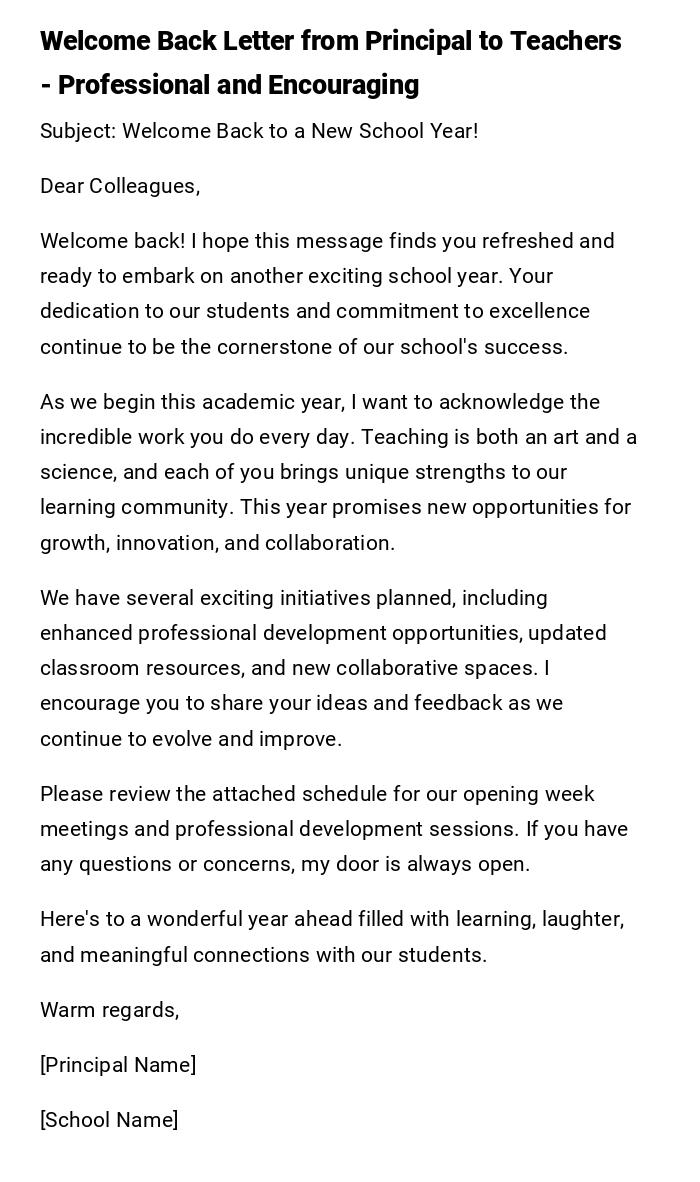
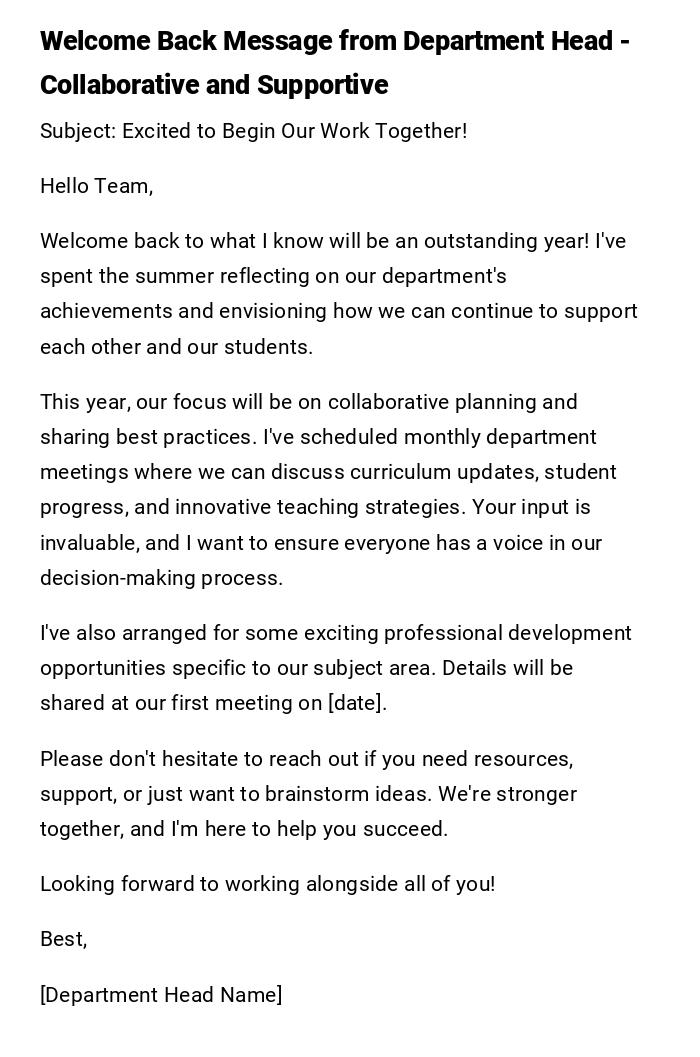

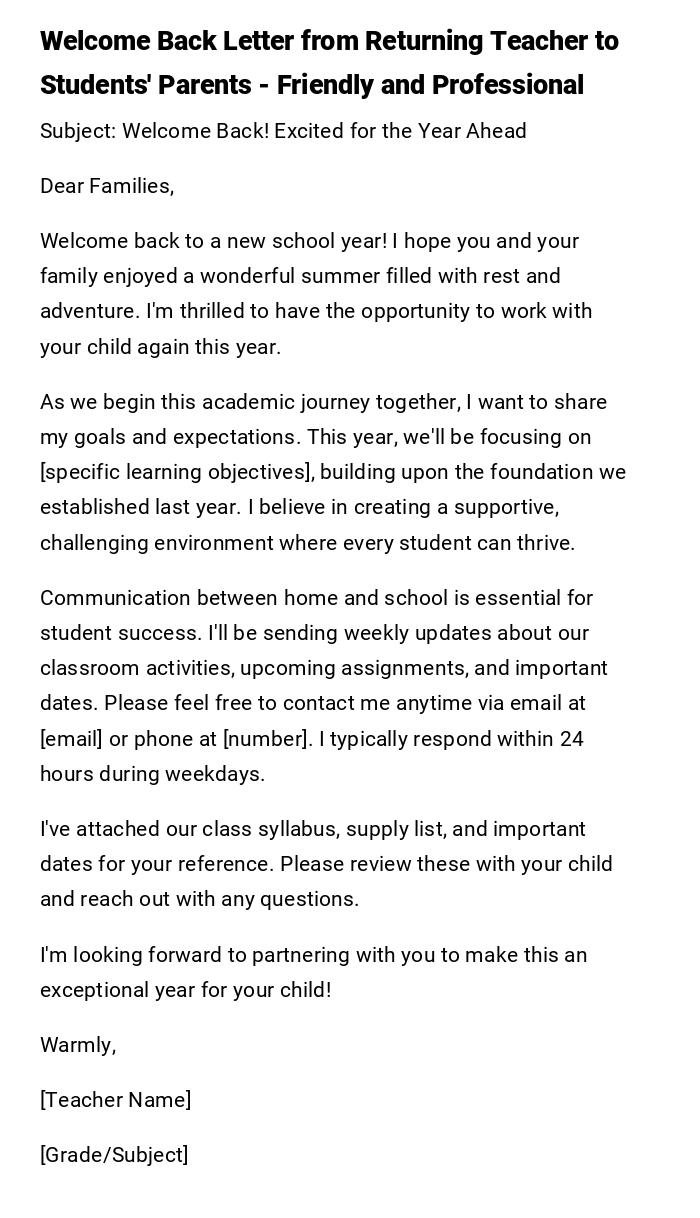
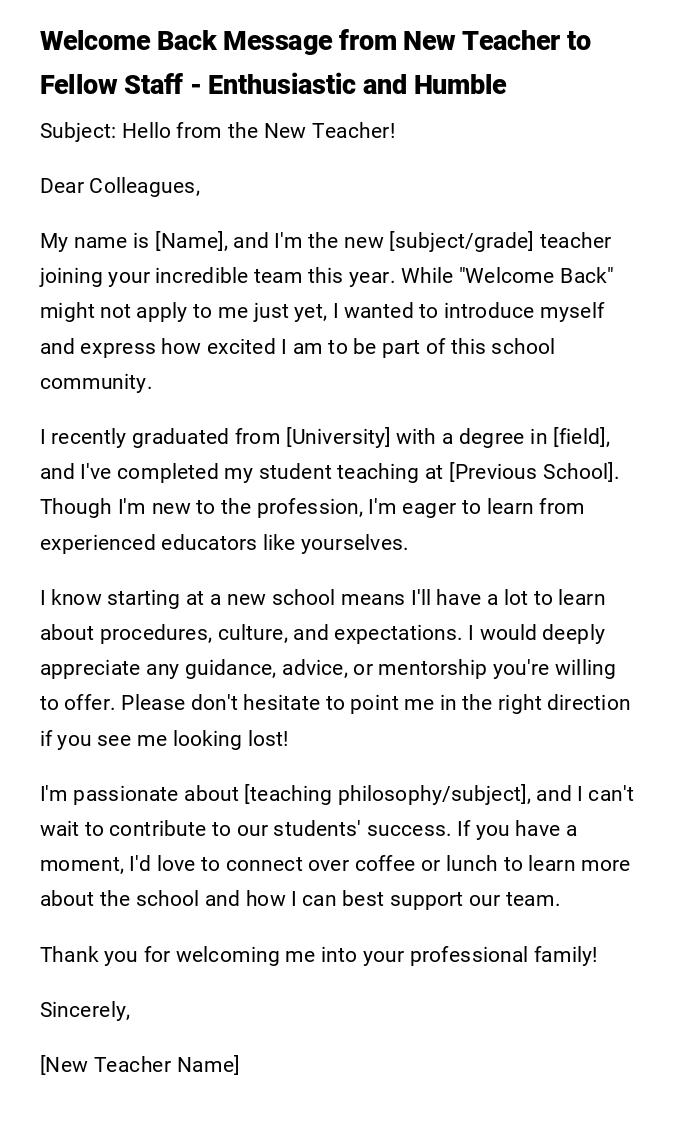
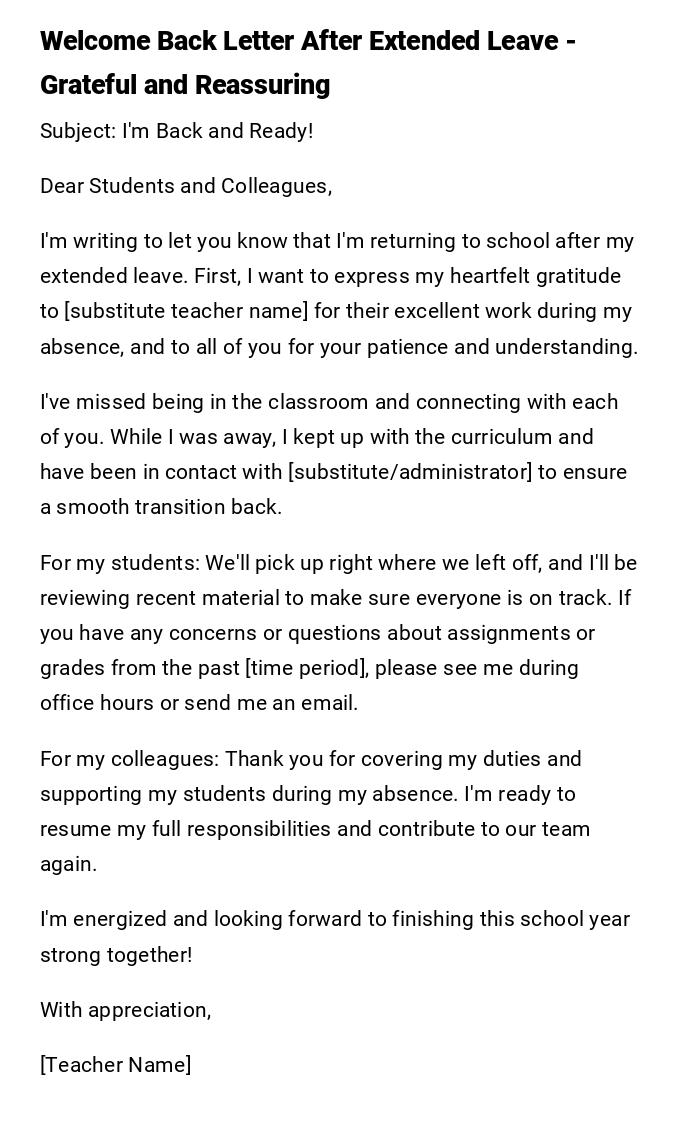
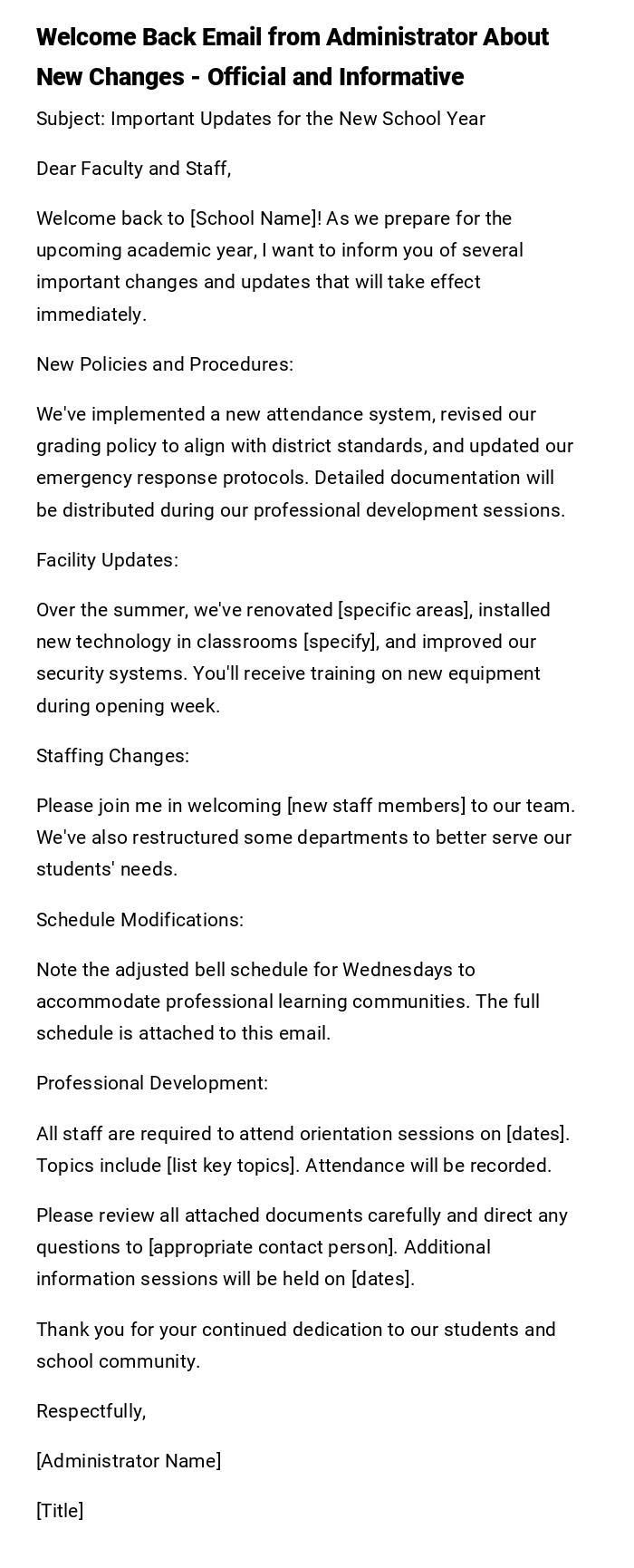
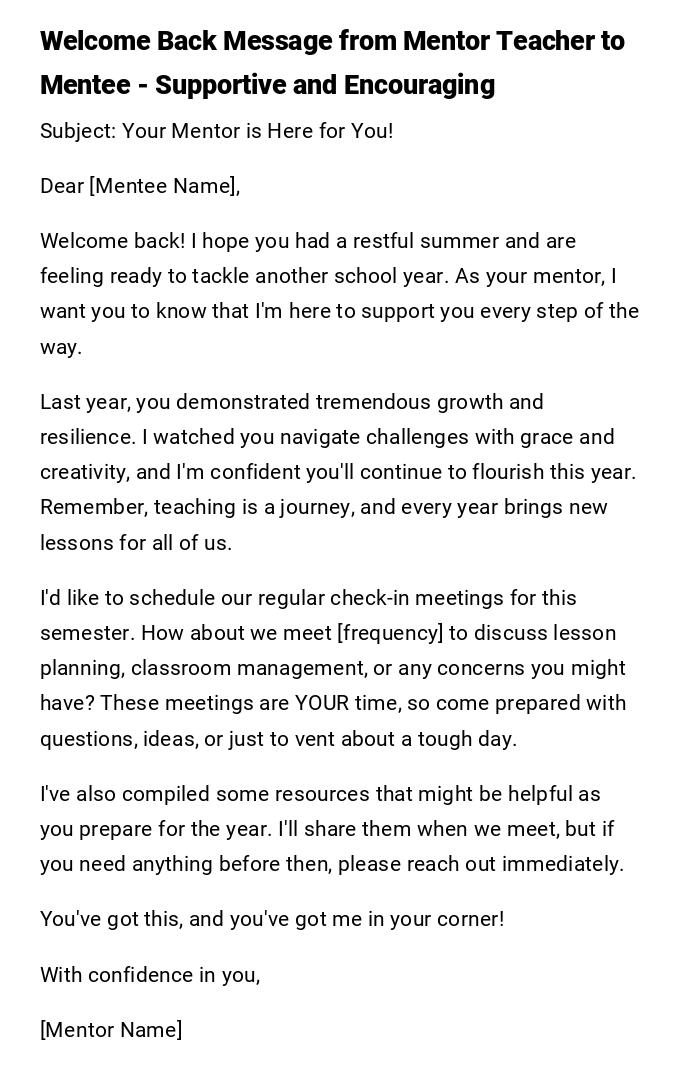

 Download Word Doc
Download Word Doc
 Download PDF
Download PDF